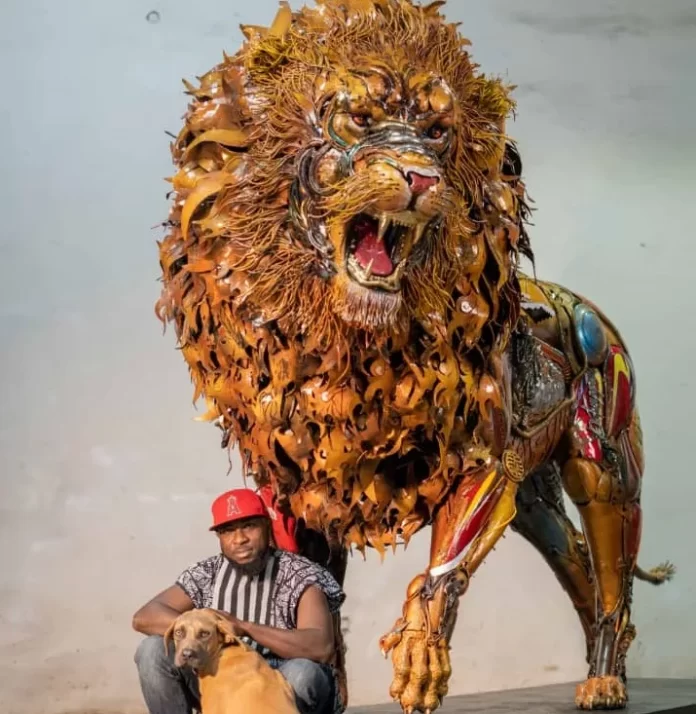Royalty, Culture, History and Arts were on display in one piece as Nigeria’s foremost sculptor, Dotun Popoola, recently delivered a splendid sculptural piece of a lion commissioned by Oba Saheed Ademola Elegushi, the Kusenla 111 of Ikate Kingdom in his palace in Lekki Lagos.
Popoola, who is also an environmental artist, gave historical insights about the artwork and a chance meeting with the monarch provided the opportunity for the work.
While characterising the two pieces of lions he was commissioned to sculpt by the king, Popoola said, “This first one reflects his fierce and bold personality while the second one will be a sitting lion that reflects his calm royal mien laced with icons, symbols, forms and colours.”
He described the work as symbolic, adding, “If there’s going to be any ornamentation to the throne of Ikate-Elegushi Kingdom, it wouldn’t be an insignia of leopard, tiger or cheetah but that of a lion and if the strength of the current King is to be historically documented, it must be related with a story of a lion. In some other African thrones, it can be other parts of lions.
“I discovered from findings that Oba Elegushi’s soft spot for lions hinges on the fact that he thinks and takes decisions like a lion. In African mythology, lion to thrones symbolises strength, bravery, good communication skills, and willingness to fight in the bigger schemes of things.”
Tracing the Ikate history from 1632 to date, the sculptor revealed that the first Kusenla ruled in 1632. After him were twenty other kings who were not crowned. “They were the white cap chiefs. The current Oba’s father Yekini Elegushi who died in 2010 discovered that Elegushi throne was superior in Lagos. He took the lead to revolutionise the Ikate-Elegushi kingdom through industrialization and urban planning of the State and that earned the kingdom a kingly place, the strength and character of a lion,” he said.
On a piece of work, Popoola said, “On the right hand side of the piece are the 21 white cap chiefs and his father while on the left is his sculpted portrait of 100 kg bronze and some of his ancestors hidden inside the lion. We also have a sculpted image of Eyo Adimu inside the piece performing for him and appealing to the gods to guide him through his reign.
“The piece was finished with anti- rust, clear coats and garnished with Ultraviolet (UV) protection to preserve it from the environment’s proximity to the sea and acid rain and salt water. It is glossy and sealed to avoid yearly maintenance and It can remain like that for the next 2-3 years.”
Popoola explained that the dominant yellow colour of the art piece was because most African lions had golden yellow colour on their body. So it was a movement towards naturalism. He added that though some of the repurposed or scrap materials used, were carefully selected from yellow parts of the scrap yard and concealed with golden yellow to give it a natural feel of a lion. “The sculpture epitomises with luxury and this is the impression that I’m creating in the minds of the people about my work,” he added.
While receiving the piece, Oba Saheed Elegushi, who turned 47 last April, felt elated and satisfied about the piece, saying. “I commissioned Dotun Poopola to produce a sculptural piece of a lion and you brought a monumental sculpture of a lion with history.
“Dotun Popoola’s artistic prowess is undeniable, and I must express my admiration for the exquisite masterpiece that has emerged from his gifted hands.
“It is for this reason I commissioned him to create lions symbolising my ancestral strength and persona. I could not have fathomed the depth to which he would elevate the concept. The resulting sculpture stands not merely as a representation of the regal lion but as a compendium of the rich history of the Ikate-Elegushi Kingdom.”
The 21st Oba of Ikate-Elegushi Kingdom revealed that the remarkable sculpture would be transformed into a luxury coffee table book which will reflect the analysis of forms and content in the sculpture and also give a creative visual insight into history of the Ikate-Elegushi Kingdom adding that he would ensure that the book would be placed in palaces and luxury places across the globe.










